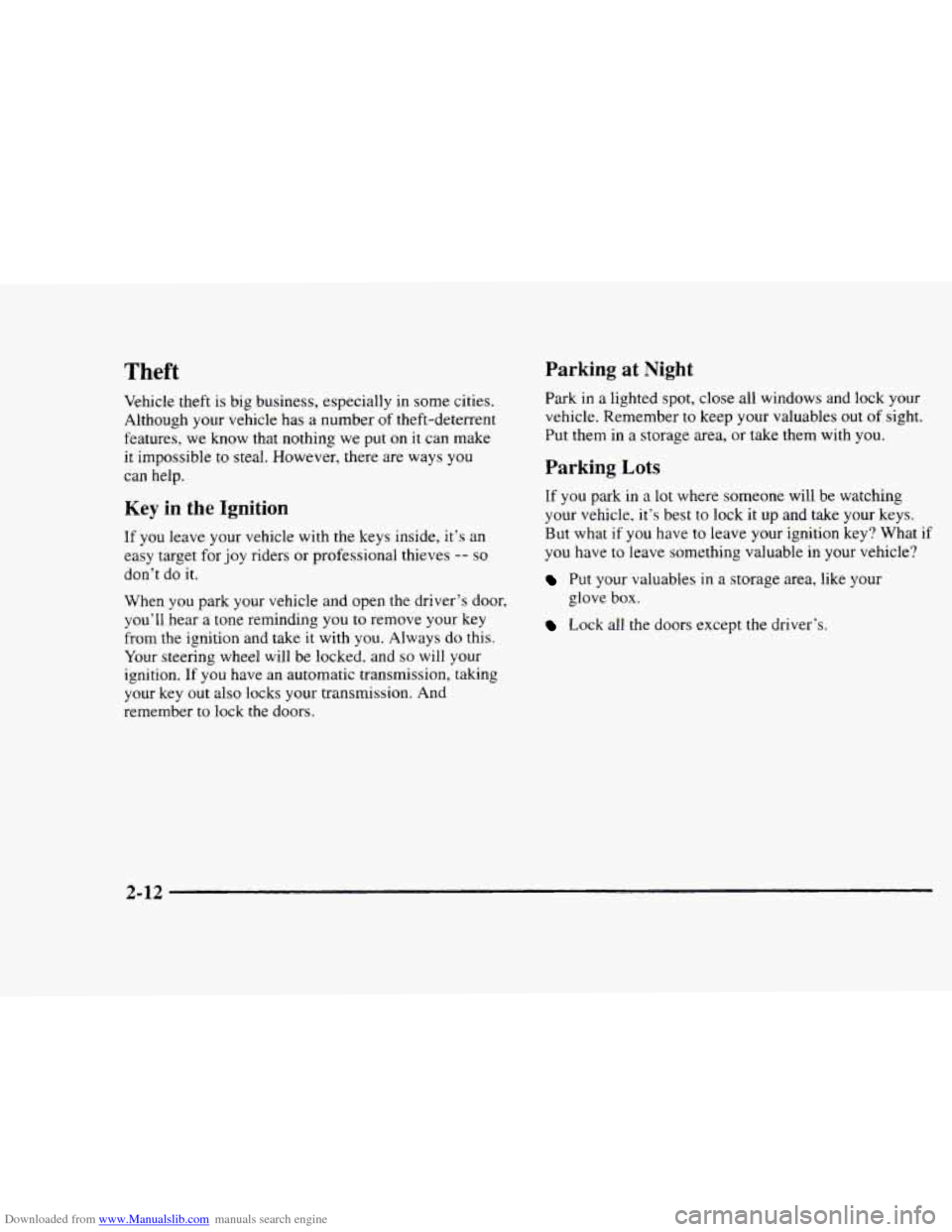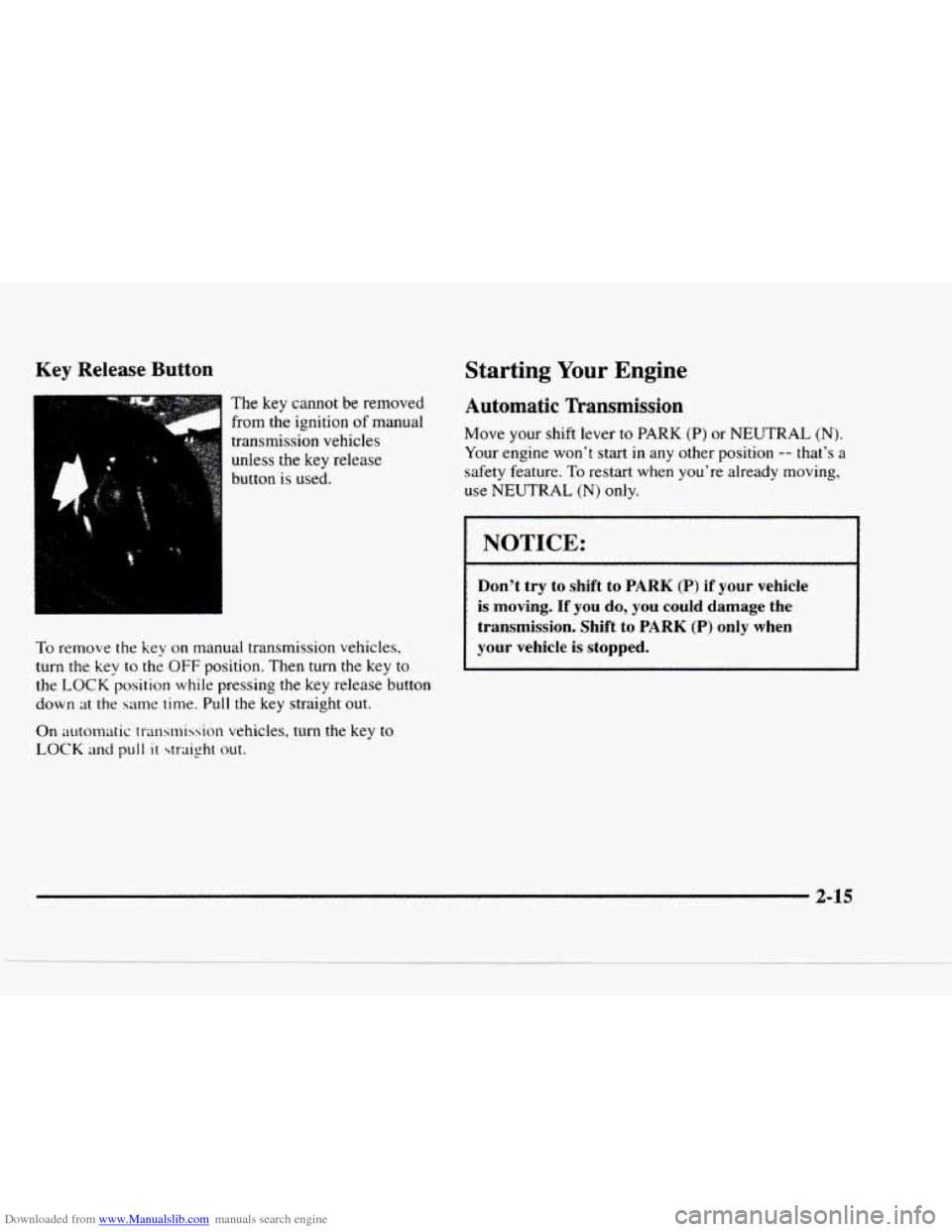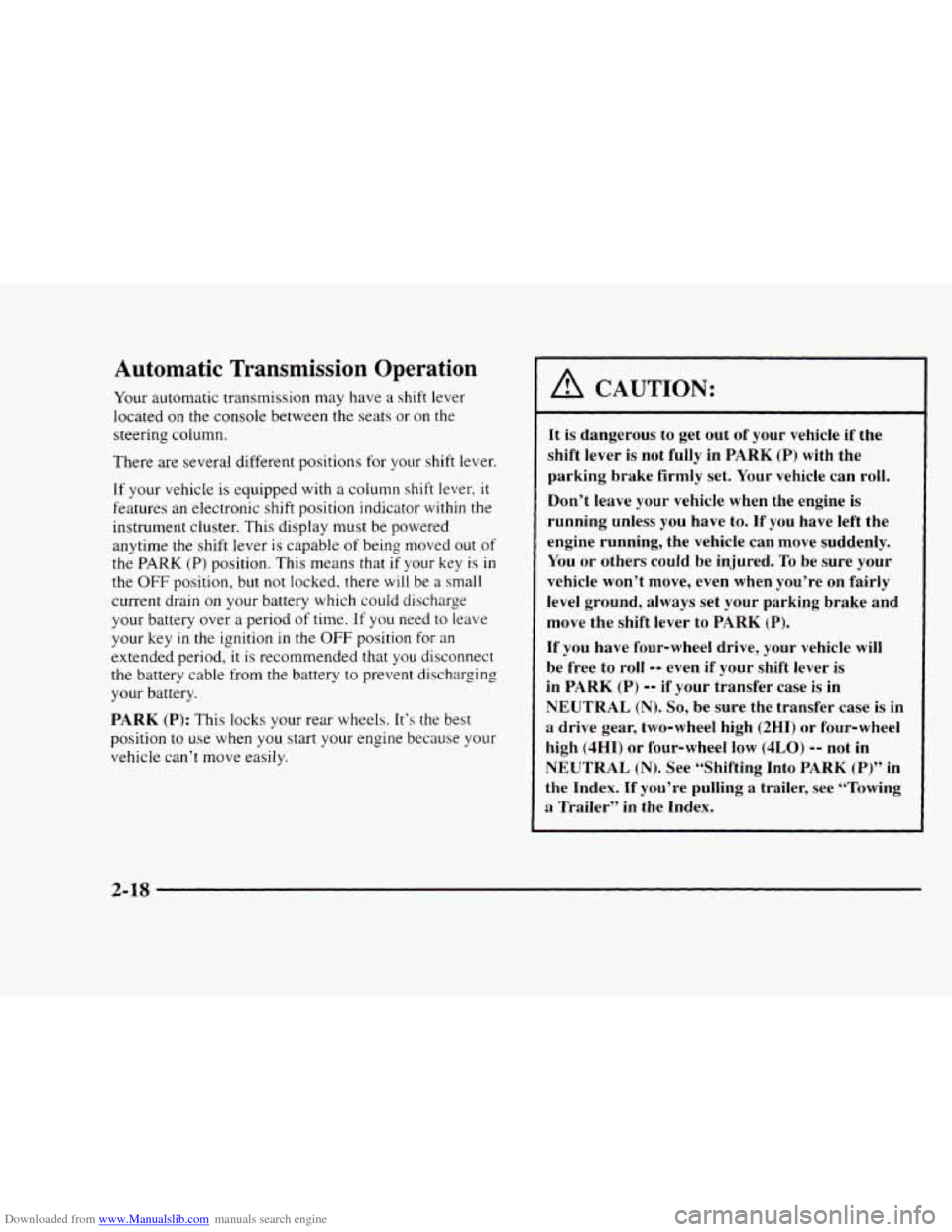1997 CHEVROLET BLAZER transmission
[x] Cancel search: transmissionPage 58 of 402

Downloaded from www.Manualslib.com manuals search engine Section 2 Features and Controls
Here you can learn about the many standard and optional features on your vehicle, and information on starting,
shifting and braking.
Also explained are the instrument panel and the warning systems that tell you if everything is
working properly -- and what to do if you have a problem.
2-2
2-6
2-9
2- 12
2-13
2-
13
2- 15
2-
17
2-18
2-2 1
2-23
2-23
2-23
2-29
2-30
2-33 Keys
Keyless Entry
System
(If Equipped)
Endgatekiftgate
Theft
New Vehicle “Break-In”
Ignition Positions
Starting Your Engine
Engine Coolant Heater (Option)
Automatic Transmission Operation
Manual Transmission
Locking Rear Axle
All-Wheel Drive (If Equipped)
Four-wheel Drive (If Equipped)
Parking Brake
Shifting Into
PARK (P) (Automatic
Transmission Models Only)
Shifting Out
of PARK (P)
(Automatic Transmission) 2-33
2-34
2-34
2-35
2-36
2-38
2-45
2-49
2-63
2-63
2- 64
2-67
2-72 Parking
Your Vehicle (Manual Transmission
Models Only) Parking Over Things That Burn
Engine Exhaust
Running Your Engine While You’re Parked
(Automatic Transmission)
Windows
Turn SignaVMultifunction Lever Exterior Lamps
Mirrors
Accessory Power Outlets (If Equipped)
Sunroof
(If Equipped)
Universal Transmitter
(If Equipped)
Instrument Panel
Warning Lights, Gages and Indicators
Page 64 of 402

Downloaded from www.Manualslib.com manuals search engine Operation
When you press UNLOCK, the driver’s door and endgate will unlock automatically.
If you press
UNLOCK again within five seconds, all doors will
unlock. Press
LOCK to lock all the doors.
Battery Replacement
Under normal use, the battery in your remote keyless
entry transmitter should
last about two years.
Press the REAR button twice within
3 1/2 seconds to
unlock and unlatch
the rear glass. If your vehicle has
an automatic transmission, the transmission must be
in PARK (P) or NEUTRAL (N).
If your vehicle has
a manual transmission, you must engage the
parking brake.
Matching Transmitter(s) To Your Vehicle
Each remote keyless entry transmitter is coded to
prevent another transmitter from unlocking your vehicle.
If a transmitter is lost or stolen, a replacement can be
purchased through your dealer. Remember to bring any
remaining transmitters
with you when you go to your
dealer. When
the dealer matches the replacement
transmitter to your vehicle, any remaining transmitters
must also be matched. Once your dealer has coded the
new transmitter, the lost transmitter will not unlock your
vehicle. Each vehicle can have only two transmitters
matched
to it.
You can tell the battery is weak if the transmitter won’t
work at the normal range in any location.
If you have to
get close to your vehicle before the transmitter works,
it’s probably time to change the battery.
NOTICE:
When replacing the battery, use care not to touch
any of the circuitry. Static from your body
transferred to these surfaces may damage
the transmitter.
2-7
Page 68 of 402

Downloaded from www.Manualslib.com manuals search engine Remote Rear Glass Release
REAR HATCH I
This button on the driver's
side
of the steering column
allows
you to release the
rear glass from inside
the vehicle.
If your vehicle has an automatic transmission, your shift
lever must be
in PARK (P) or NEUTRAL (,N) for the
release to work.
If you have
a manual transmission, either with or
without the Keyless Entry option, you must apply your
parking brake before you can open
the endgate glass.
Liftgate Release
Insert the key in the lock button and turn
counterclockwise. All doors will unlock. You may also use
the power lock switches or the keyless entry system, if
your vehicle
is so equipped. Use the handle to open the
liftgate. Press the button
to open the glass when the liftgate
is closed. The glass won't release if the vehicle
is in gear.
Emergency Release for Opening
EndgateLiftgate
1. Peel back or slit the carpet locally to expose the
access hole
in the trim panel.
ii 2. Use a thin screwdriver
1
~ 2'''
to reach through the
access holes in both the
trim panel and the
hardware cover.
Pry the release lever
toward the passenger's
side until
the glass latch
pops open.
3. Reattach the carpet securely.
- 44
Page 69 of 402

Downloaded from www.Manualslib.com manuals search engine Theft Parking at Night
Vehicle theft is big business, especially in some cities.
Although your vehicle has a number
of theft-deterrent
features, we know that nothing we put on
it can make
it impossible
to steal. However, there are ways you
can help.
Key in the Ignition
If you leave your vehicle with the keys inside, it’s an
easy target for
joy riders or professional thieves -- so
don‘t do it.
When you park your vehicle and open the driver’s door,
you’II hear a tone reminding
you to remove your key
from the ignition and take it with you. Always do this.
Your steering wheel will be locked. and
so will your
ignition. If you have an automatic transmission, taking
your key
out also locks your transmission. And
remember to lock the doors. Park
in a
lighted spot, close all windows and lock your
vehicle. Remember
to keep your valuables out of sight.
Put them in a storage area, or take them with you.
Parking Lots
If you park in a lot where someone will be watching
your vehicle. it’s best
to lock it up and take your keys.
But what
if you have to leave your ignition key? What if
you have to leave something valuable in your vehicle?
Put your valuables in a storage area, like your
glove box.
Lock all the doors except the driver’s.
2-12
Page 71 of 402

Downloaded from www.Manualslib.com manuals search engine NOTICE:
Don’t operate accessories in the ACCESSORY
position for long periods
of time. Prolonged
operation
of accessories in the ACCESSORY
position could drain your battery and prevent
you from starting your vehicle.
LOCK
(B): This position locks your ignition, steering
wheel and transmission. It’s
a theft-deterrent feature.
You will only be able to remove your key when the
ignition
is turned to LOCK.
OFF (C): This position lets you turn off the engine but
still turn the steering wheel. Use OFF if you must have
your vehicle
in motion while the engine is off (for
example,
if your vehicle is being towed).
RUN (D): This is the position for driving.
START (E): This starts your engine.
A CAUTION:
On manual transmission vehicles, turning the key
to LOCK will lock the steering column and result
in
a loss of ability to steer the vehicle. This could
cause a collision.
If you need to turn the engine
off while the vehicle is moving, turn the key only
to
OFF. Don’t press the key release button while
the vehicle
is moving.
_. .
NOTICE^^' Y!’> .‘sa !-
If your key seems stuck in LOCK and you can’t
turn it, be sure you are using the correct key; if
so, is it all the way in? If it is, then turn the
steering wheel left and right while you turn the
key hard. But turn the key only with your hand.
Using a tool to force
it could break the key or the
ignition switch.
If none of this works, then your
vehicle needs service.
2-14
Page 72 of 402

Downloaded from www.Manualslib.com manuals search engine Key Release Button
ca The key cannot be removed
9.-
from the ignition of manual
transmission vehicles
unless the key release
button
is used.
To remove the key on manual transmission vehicles,
turn
the key to the OFF position. Then turn the key to
the
LOCK position while pressing the key release button
down
at the same time. Pull the key straight out.
On automatic
transmission vehicles, turn the key to
LOCK and pull it straight out.
Starting Your Engine
Automatic Transmission
Move your shift lever to PARK (P) or NEUTRAL (N).
Your engine won't start in any other position -- that's a
safety feature. To restart when you're already moving,
use
NEUTRAL (N) only.
I NOTICE:
Don't try to shift to PARK (P) if your vehicle
is moving. If you do, you couId damage the
transmission. Shift
to PARK (P) only when
your vehicle is stopped.
2-15
Page 73 of 402

Downloaded from www.Manualslib.com manuals search engine Manual Transmission
The gear selector should be in NEUTRAL (N). Hold the
clutch pedal to the
floor and start the engine. Your
vehicle won’t start
if the clutch pedal is not all the way
down
-- that’s a safety feature.
1. Without pushing the accelerator pedal, turn your
ignition key to START. When the engine starts, let
go of the key. The idle speed will go down as your
engine gets warm.
NOTICE:
Holding your key in START for longer than
15 seconds at a time will cause your battery to be
drained much sooner.
And the excessive heat can
damage your starter motor.
2. If it doesn’t start right away, hold your key in
START. If it doesn‘t start in 10 seconds, push the
accelerator pedal
all the way down for five more
seconds. or
until it starts.
3. If your engine still won’t start (or starts but then
stops), wait
15 seconds and start over.
When the engine starts,
let go of the key and the
accelerator pedal.
NOTICE:
Your engine is designed to work with the
electronics in
your vehicle. If you add electrical
parts
or accessories, you could change the way
the engine operates. Before adding electrical
equipment, check with your dealer.
If you don’t.
your engine might not perform properly.
If you ever have to have your vehicle towed, see
the part
of this manual that tells how to do it
without damaging your vehicle. See “Towing
Your Vehicle” in the Index.
2-16
Page 75 of 402

Downloaded from www.Manualslib.com manuals search engine Automatic Transmission Operation
Your automatic transmission may have a shift lever
located
on the console between the seats or on the
steering column.
There are several different positions
for your shift lever.
If your vehicle is equipped with a coiunm shift lever, it
features an electronic shift position indicator within the
instrument cluster. This display must be powered
anytime the shift lever is capable of being moved out of
the
PARK (P) position. This means that if your key is in
the
OFF position, but not locked, there will be a small
current drain
on your battery which could discharge
your battery over
a period of time. If you need to leave
your key
in the ignition in the OFF position for an
extended period, it is recommended that you disconnect
the battery cable from the battery to prevent discharging
your battery.
PARK (P): This locks your rear wheels. It’s the best
position to use when you start your engine because your
vehicle can‘t move easily.
A CAUTION:
It is dangerous to get out of your vehicle if the
shift lever
is not fully in PARK (P) with the
parking brake firmly set. Your vehicle can roll.
Don’t leave your vehicle when the engine
is
running unless you have to. If you have left the
engine running, the vehicle can move suddenly.
You or others
could be injured. To be sure your
vehicie won’t move, even when you’re on fairly
level ground, always set your parking brake and
move the shift lever to
PARK (P).
If you have four-wheel drive, your vehicle will
be free to
roll -- even if your shift lever is
in PARK (P) -- if your transfer case is in
NEUTRAL (N). So, be sure the transfer case is in
a drive gear, two-wheel high (2HI) or four-wheel
high (4HI) or four-wheel low (4LO) -- not in
NEUTRAL (Nj. See “Shifting Into PARK (P)” in
the Index.
If you’re pulling a trailer, see “Towing
a Trailer” in the Index.
2-18